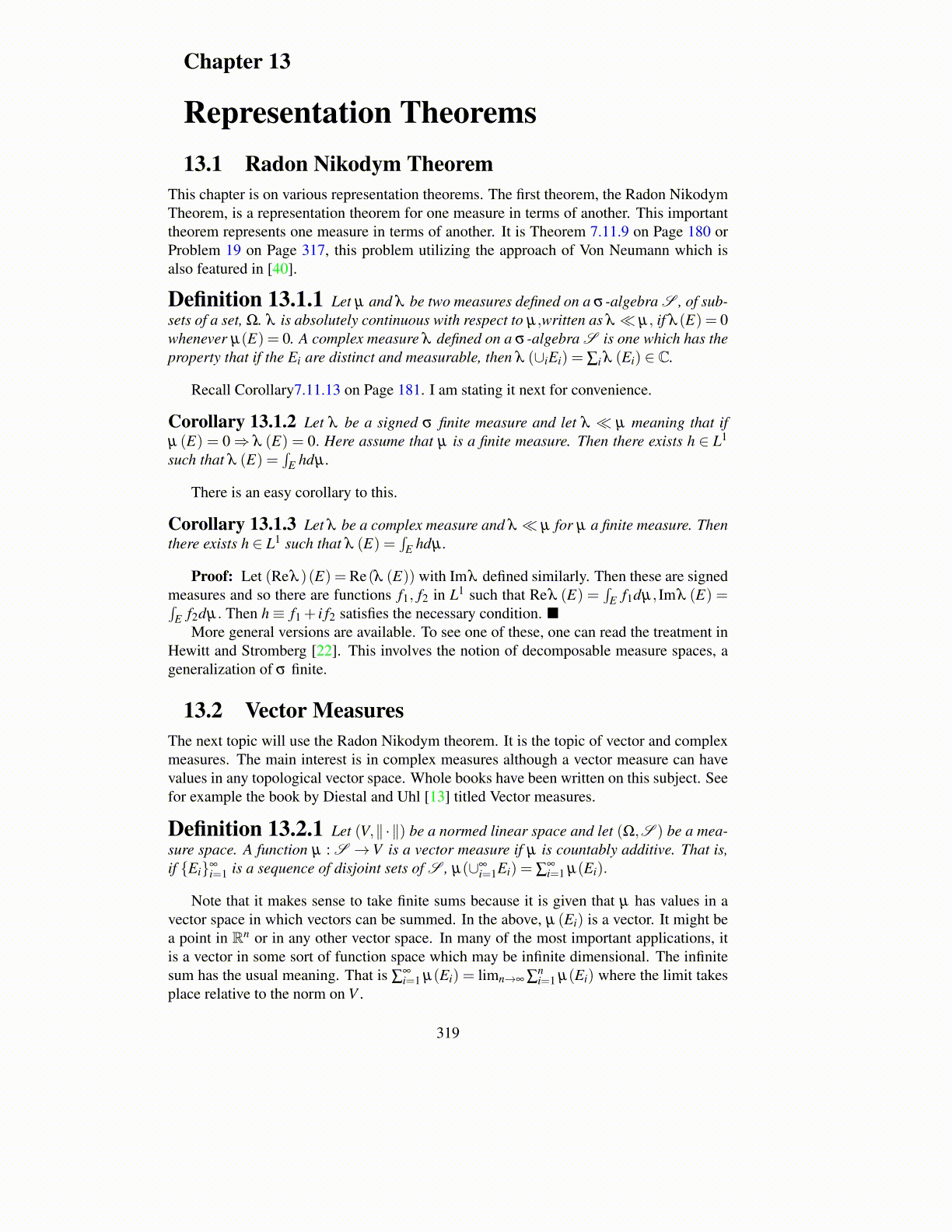
Chapter 13
Representation Theorems13.1 Radon Nikodym Theorem
This chapter is on various representation theorems. The first theorem, the Radon NikodymTheorem, is a representation theorem for one measure in terms of another. This importanttheorem represents one measure in terms of another. It is Theorem 7.11.9 on Page 180 orProblem 19 on Page 317, this problem utilizing the approach of Von Neumann which isalso featured in [40].
Definition 13.1.1 Let µ and λ be two measures defined on a σ -algebra S , of sub-sets of a set, Ω. λ is absolutely continuous with respect to µ,written as λ ≪ µ, if λ (E) = 0whenever µ(E) = 0. A complex measure λ defined on a σ -algebra S is one which has theproperty that if the Ei are distinct and measurable, then λ (∪iEi) = ∑i λ (Ei) ∈ C.
Recall Corollary7.11.13 on Page 181. I am stating it next for convenience.
Corollary 13.1.2 Let λ be a signed σ finite measure and let λ ≪ µ meaning that ifµ (E) = 0⇒ λ (E) = 0. Here assume that µ is a finite measure. Then there exists h ∈ L1
such that λ (E) =∫
E hdµ .
There is an easy corollary to this.
Corollary 13.1.3 Let λ be a complex measure and λ ≪ µ for µ a finite measure. Thenthere exists h ∈ L1 such that λ (E) =
∫E hdµ .
Proof: Let (Reλ )(E) = Re(λ (E)) with Imλ defined similarly. Then these are signedmeasures and so there are functions f1, f2 in L1 such that Reλ (E) =
∫E f1dµ, Imλ (E) =∫
E f2dµ. Then h≡ f1 + i f2 satisfies the necessary condition. ■More general versions are available. To see one of these, one can read the treatment in
Hewitt and Stromberg [22]. This involves the notion of decomposable measure spaces, ageneralization of σ finite.
13.2 Vector MeasuresThe next topic will use the Radon Nikodym theorem. It is the topic of vector and complexmeasures. The main interest is in complex measures although a vector measure can havevalues in any topological vector space. Whole books have been written on this subject. Seefor example the book by Diestal and Uhl [13] titled Vector measures.
Definition 13.2.1 Let (V,∥ · ∥) be a normed linear space and let (Ω,S ) be a mea-sure space. A function µ : S → V is a vector measure if µ is countably additive. That is,if {Ei}∞
i=1 is a sequence of disjoint sets of S , µ(∪∞i=1Ei) = ∑
∞i=1 µ(Ei).
Note that it makes sense to take finite sums because it is given that µ has values in avector space in which vectors can be summed. In the above, µ (Ei) is a vector. It might bea point in Rn or in any other vector space. In many of the most important applications, itis a vector in some sort of function space which may be infinite dimensional. The infinitesum has the usual meaning. That is ∑
∞i=1 µ(Ei) = limn→∞ ∑
ni=1 µ(Ei) where the limit takes
place relative to the norm on V .
319